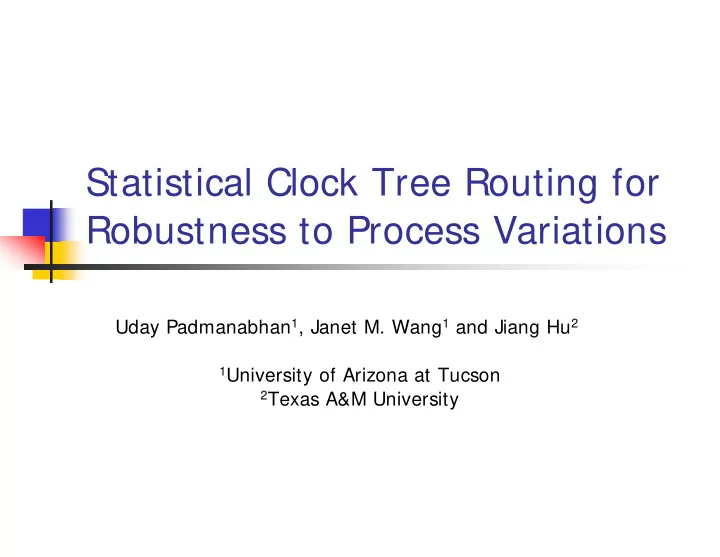

Statistical Clock Tree Routing for Robustness to Process Variations Uday Padmanabhan 1 , Janet M. Wang 1 and Jiang Hu 2 1 University of Arizona at Tucson 2 Texas A&M University
Outline � Previous research � Motivation of this project � Variation aware delay model � Statistical centering algorithm � Examples � Conclusion
Clock Tree Routing
Previous Research � Layout embedding method to achieve zero skew � Deferred Merging Embedding technique (DME) � Nearest neighbor based abstract tree method (NNA) � Bounded skew tree (BST) algorithm � Minimal Skew Violations (MinSV)
Align the mean to the center Permissible Range
Skew and Permissible Range
Basic Concepts
Existing Issues � Most of the research works are for deterministic clock tree routing � Some research works consider corner cases not work well with statistical clock skew
Possible Strategies � Skew can be non-Gaussian distributed: asymmetric � Only mean and variance are not enough � Our methodology: � include high order moments � center measures include: Mode, Median and Mean
A Task List � Variation aware delay model � Parameter reduction based on ANOVA and OPCA � Choose among Mean, Median and Mode as Central Measures � Select wire length based on Central Measures � Variation aware abstract tree topology
Delay model ∑ ∑ ∑ = + + d Ar c l w Br c l C r cL FED k d d i i d f i d j ∈ ∈ ∈ i T i T j S l l w ∑ ∑ + ρ + i i i ( ) D c l w a j j 2 w t ∈ ∈ i P j E i i k i l l ∑ ∑ + ρ + i i ( ) E c l f j 2 w t ∈ ∈ i P j E i i k i l ∑ ∑ + ρ i ( ) F cL j w t ∈ ∈ i P j S i i k i
Delay Mean and variance µ = + | d = µ = µ = µ = µ , , , T FED w t r c w t d rd L cL ρ 2 ρ c l 1 1 lc + + f [( 2 L ) E F µ 3 2 t t w ρ 2 ρ c l 1 lc + ρ + + 2 f ( 2 L ) ] D c l E F First Order Estimates µ a 3 w w t ∂ ∂ d d σ σ + σ 2 2 2 2 2 ( F E D ) ( F E D ) ∂ ∂ T r d c L r c d L ∂ ∂ d d + σ + σ 2 2 2 2 F E D F E D ( ) ( ) ∂ ∂ w t w t
Delay Mean and Variance = ∑ = ∑ µ µ σ σ 2 2 Til Tk Til Tk ∈ n7 ∈ k P k P il il µ = µ − µ Path Slr Til Tjr n6 n5 σ = σ + σ 2 2 2 Slr Til Tjr S1 S4 S2 S3
Delay Median Path Delay Median: Edge Delay Median: Skew Median:
Matching the delay mode by Weibul function: Delay Mode
ANOVA n7 µ = µ + µ ( , , , ) ( , ) ( , ) w t w t w t w t P 1 1 2 2 s n , 1 1 n n , 2 2 Path 1, 7 1 5 5 7 s n n6 n5 S1 S4 S2 S3 µ µ = µ + µ ( , , ) ( , ) w t w t 1 1 , 1 1 , P n n s n n n s 1, 7 n 5, 7 1 5 5 7
Statistical Centering Based Layout Embedding
Statistical Centering Based Layout Embedding
Mean, Median and Mode based design where
Variation Aware Abstract Tree Topology � Extend the Nearest Neighbor Algorithm (NNA) � Length is positive dependent on the distance between nodes � The minimal composite distance
Process variation model
Experimental Results
Experimental Results
Experimental Results
Run Time Comparison
Conclusions � A Statistical centering approach � A Fitted Elmore delay model with analysis of variance and principle component analysis � A topology generation algorithm which takes the width and thickness into consideration
Recommend
More recommend